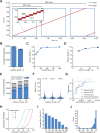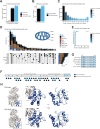Fast and deep phosphoproteome analysis with the Orbitrap Astral mass spectrometer
- PMID: 39147754
- PMCID: PMC11327265
- DOI: 10.1038/s41467-024-51274-0
Fast and deep phosphoproteome analysis with the Orbitrap Astral mass spectrometer
Abstract
Owing to its roles in cellular signal transduction, protein phosphorylation plays critical roles in myriad cell processes. That said, detecting and quantifying protein phosphorylation has remained a challenge. We describe the use of a novel mass spectrometer (Orbitrap Astral) coupled with data-independent acquisition (DIA) to achieve rapid and deep analysis of human and mouse phosphoproteomes. With this method, we map approximately 30,000 unique human phosphorylation sites within a half-hour of data collection. The technology is benchmarked to other state-of-the-art MS platforms using both synthetic peptide standards and with EGF-stimulated HeLa cells. We apply this approach to generate a phosphoproteome multi-tissue atlas of the mouse. Altogether, we detect 81,120 unique phosphorylation sites within 12 hours of measurement. With this unique dataset, we examine the sequence, structural, and kinase specificity context of protein phosphorylation. Finally, we highlight the discovery potential of this resource with multiple examples of phosphorylation events relevant to mitochondrial and brain biology.
© 2024. The Author(s).
Conflict of interest statement
J.J.C. is a consultant for Thermo Fisher Scientific and on the scientific advisory board for Seer and 908 Devices. T.N.A., A.P., H.S., C.H., E.D., and V.S. are employees of Thermo Fisher Scientific. The remaining authors declare no competing interests.
Figures







Update of
-
Fast and Deep Phosphoproteome Analysis with the Orbitrap Astral Mass Spectrometer.bioRxiv [Preprint]. 2024 May 16:2023.11.21.568149. doi: 10.1101/2023.11.21.568149. bioRxiv. 2024. Update in: Nat Commun. 2024 Aug 15;15(1):7016. doi: 10.1038/s41467-024-51274-0. PMID: 38045259 Free PMC article. Updated. Preprint.
References
MeSH terms
Substances
Grants and funding
LinkOut - more resources
Full Text Sources
Medical

